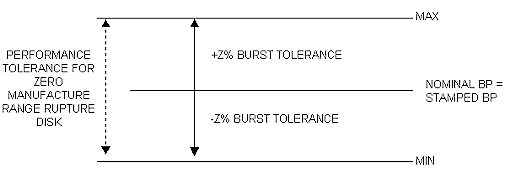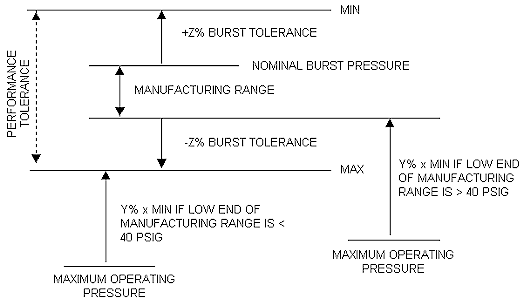Rupture Disk Specification
Whilst every effort is made to ensure technical accuracy of the information supplied on iceweb.com.au, Keyfleet Pty Ltd and its employees accept no liability for any loss or damage caused by error or omission from the data supplied. Users should make and rely on their own independent inquiries. By accessing the site users accept this condition. Should you note any error/omission or an article offends please do not ignore it, contact the This email address is being protected from spambots. You need JavaScript enabled to view it. and we will review, rectify and remove as necessary.
Provided by POGC Sensor Technology
Performance Tolerance
A simple way of understanding and comparing rupture disk specifications is to recognise the definition given by AS1358-1989 for PERFORMANCE TOLERANCE (section 1, definition 1.2.8, as follows):
“Performance tolerance - a range of pressure in positive and negative quantities or percentages which include both manufacturing range and bursting tolerance at a coincident temperature, which is applied directly to the specified bursting pressure.”
-
Section 1, AS1358 is available here.
A rupture disk is usually specified using a MIN-MAX range of pressure at a specified temperature. When a MIN-MAX range is given by the supplier, the other specific details necessary to specify are:
-
The nominal burst pressure
-
The manufacturing range
-
The burst tolerance
In some cases suppliers try to confuse the issue by stating a MIN/MAX but applying it to the manufacturing range only. The above (1-3) should be asked of the supplier to ensure their complete understanding of the true MIN/MAX per AS1358 as the true MIN/MAX incorporates not only the manufacturing range but also all burst tolerances.
The performance tolerance can be shown in the following diagrammatical arrangement.

The inclusion of manufacturing ranges and tolerances in the PERFORMANCE TOLERANCE means that the batch of disks being ordered today and future batches will not burst outside this range at the at the customer’s specified coincident temperature.
The testing that is done in the factory determines the actual burst pressure of the batch. If the customer nominates ASME VIII certification, 2 tests are made in an oven at the customer’s coincident burst pressure. The average of these tests must lie in the manufacturing range and is stamped on the disk tab in accordance with ASME VIII. If ASME certification is needed, then the stamping on the disk tab cannot vary.
If stamping is needed to be MIN/MAX one can specify the same stringent testing as the ASME code by stating that the testing shall include at least 2 tests at the elevated, coincident temperature that fall in the manufacturing range, eg they can then specify in accordance with ISO6718. This is the code that AS1358 has been written around.
Essentially, if you ask for a tighter MIN/MAX, you are asking for a tighter manufacturing range. Manufacturing ranges are specified in the manufacturers’ literature. A zero manufacturing range is the tightest, meaning the average of the burst tests in the factory must equal the nominal burst pressure at the coincident temperature.

The burst tolerance is always ±5% in accordance with all the rupture disk codes for stamped burst pressure equal to or greater than 40 PSIG (275.8 kPag) @ 22 ºC.
The burst tolerance varies, according to the particular disk design for stamped burst pressures below 40 PSIG @ 22 ºC.
The burst tolerance refers to the accuracy of each disk in the batch you have just received.
Essentially, once it has been confirmed what manufacturing range (ask the manufacturer to specify low end and high end) and what burst tolerance applies to the high end and low end of the manufacturing range, then the performance tolerance is worked out. If the supplier cannot provide this detail then they should confirm that all manufacturing ranges and tolerances are included in the MIN/MAX they have given.
Maximum Operating Pressure
Any rupture disk can be operated to whatever pressure one likes. However, at what pressure should one operate to for reliable performance, so that the life of the disk is not reduced? From more than 65 years experience in the field BS&B has established the following operating pressure to burst pressure ratios (expressed as %). Some examples are:
| BS&B Types | Description | Operate from Full Vacuum to Y% of the Stamped BP |
|
S90, JRS, CSR, RLS, MRB, ECR |
Single Section reverse buckling disk |
90% |
|
GFN |
Tension loaded disk that is scored after disk crowned |
85% |
|
XN, LCN, DV |
Composite tension loaded disk |
80% |
|
EXP/DV |
Tension loaded, domed, composite disk with vacuum support |
80% of nominal |
|
AV, AVV |
Flat composite disk with gaskets |
60% of minimum |
|
BV |
Tension loaded, solid metal prebulged disk with vacuum support |
70% |
|
MBV |
Integral disk & holder of high grade impregnated graphite with vacuum support |
80% |
Cyclic / Pulsating Duties
The next question is which disks can be operated reliably in cyclic/pulsating duties.
The answers are S90, JRS, RLS, MRB & ECR. All others are tension-loaded disks that will have a limited cycle life but are very good in static conditions. Hence, the operating ratio can be qualified only depending on the type of service that the disk is used in. This optimum value must therefore be seen with caution.
On the specification sheet, the next step is to specify the maximum positive operating pressure that the disk should see, at the coincident burst temperature to ensure maximum service life.
To specify this, for the worst case condition one must establish first, if the low end of the manufacturing range will be:
-
40 PSIG or higher
-
Lower than 40 PSIG
Case A - 40 PSIG or Higher
In this case, you may operate to Y% of the stamped burst pressure (at worse case Y% of the minimum of the manufacturing range).
Case B - Lower than 40 PSIG
In this case you may operate to Y% of the MIN. hence the burst tolerance must be deducted from the stamped burst pressure (at worse case the burst tolerance is deducted from the low end of the manufacturing range and the MIN is calculated. Then Y% is applied to the MIN).

The performance of rupture disks at temperatures other than the coincident disk temperature cannot be guaranteed unless the user is prepared to pay for extra testing. Estimates can be given for various disk materials, although these should not be taken for granted.
Section 1: Scope and General
Australian Standard AS1358: Bursting Disks and Bursting Disk Devices





